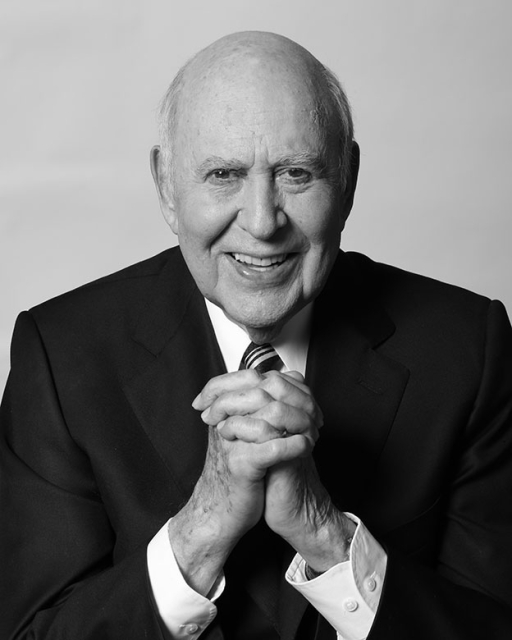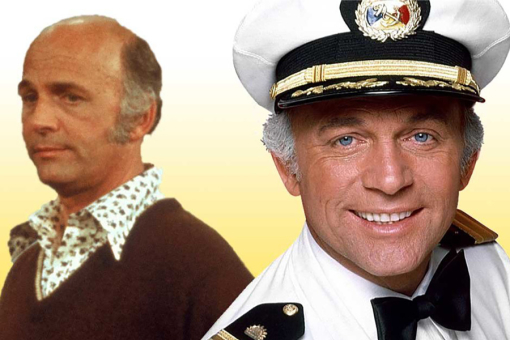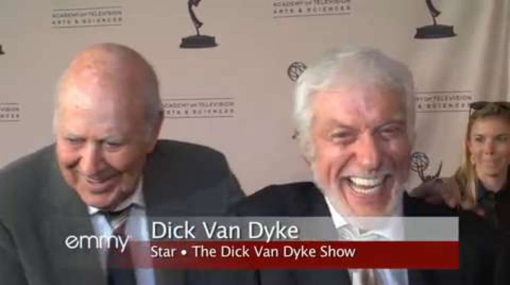Ten years after The Dick Van Dyke Show debuted on CBS, October 3, 1961, The New Dick Van Dyke Show premiered on CBS, September 18, 1971.
Instead of playing Rob Petrie, a TV comedy/variety writer on The Alan Brady Show, Van Dyke portrayed Dick Preston, the host of his own TV talk show. Instead of being married to Mary Tyler Moore as Laura Petrie, Van Dyke was wed to Hope Lange as Jenny Preston.
The Petries had one son, Ritchie, played by Larry Mathews. The Prestons had two, then three children: the pre-teen Annie played by Angela Powers, a college-age Lucas, played by Michael Shea in the first two years, then Wendell Burton in the final season; Jenny would give birth to a third offspring in the second season.
The Petries lived in New Rochelle, New York, in black and white, for five seasons (until 1966). The Prestons lived in Phoenix, and later, Los Angeles, in color, for three years (until 1974).
Rob Petrie's co-workers were funny and loyal Morey Amsterdam, Rose Marie, and Richard Deacon. Rob's neighbors were just as charming and engaging in the form of Jerry Paris and Ann Morgan Guilbert.
Dick Preston's friends and fellow employees changed over three seasons, but each brought their own personal brand of likability. Marty Brill was Dick Preston's manager Bernie Davis, who was married to Carol, played by Nancy Dussault. They, along with Fannie Flagg, as Dick's sister 'Mike' Preston, and David Doyle as Ted Atwater, TV station manager, appeared in the first two years.
In the third season, Dick moved to Hollywood, became a star on the fictitious afternoon TV soap opera, Those Who Care, and had a new set of friends and co-workers. Richard Dawson and Chita Rivera (Van Dyke's friend and former co-star from Broadway's Bye, Bye Birdie) played neighbors Richard and Connie Richardson.
Dick Van Patten was Dick's new boss Max Mathias, and Those Who Care's production team included Barry Gordon as writer Dennis Whitehead, and Henry Darrow as stage manager Alex Montenez, while Barbara Rush played daytime drama diva Margot Brighton.
Familiar faces from the original Van Dyke series periodically materialized on the New edition, like stalwart Herbie Faye, and Frank Adamo, who was assistant to Van Dyke in real life (and later, Mary Tyler Moore). Even Van Dyke's real-life children Carrie Beth, Stacy, Chris, and Barry Van Dyke, the latter of whom performed on screen the most with his dad over the years, made appearances on the show.
Barry would later co-star in The Van Dyke Show (CBS, 1988), and Diagnosis Murder (CBS, 1993–2001), which was a huge success for his father.
But it's against the elder Van Dyke's original sitcom to which all other of his shows, including and specifically The New Dick Van Dyke Show, have been inevitably measured. Both programs were guided by the core creative force of Carl Reiner, who played Alan Brady on the initial series. And that only raised the comparative stakes even higher.
New executive producers Bernie Orenstein and Sault Turtletaub had completed a successful run of That Girl which, like the original Van Dyke show, was filmed at Desilu Studios, by then owned and operated soley by Lucille Ball. Orenstein discusses the synergy that led to the new Van Dyke program:
"When we were doing That Girl, they were doing The Dick Van Dyke Show in adjoining stage. So, we took over That Girl from Bill Persky and Sam Denoff, who were writers on The Dick Van Dyke Show. It was a family atmosphere at Desilu. The Dick Van Dyke Show was a big show, and we sort of envied them. So, the offer to do The New Dick Van Dyke Show was very appealing. When Carl Reiner asked us if we would do it, we said, 'Of course!'"
Reiner's "creator" credit on the New show, however, was unclear, at least on screen, where he was billed as "creative consultant." Orenstein explains:
"First of all, the titles on sitcoms are all very loose. I am not even sure we called Carl 'creator.' Maybe we did. He came up with the idea of the show when he heard that Dick was willing to do another show, on the condition it was done in Cave Creek, Arizona, where Dick lived.
"So, Carl came up with the show and it was not that original idea for a sitcom. However, he would consult with us on the story topics and flew in every week from L.A. for the [table] read. And that was his contribution, which was huge. The big thing for us was the move to Arizona. Saul...I think he moved with his family. I moved. I had a place there. But I used to go home on the weekends."
"Saul was one of the funniest partners you could ever have," Orenstein goes on to say. "We worked together for 50 years." The two writers had different approaches to their work, but they divided their efforts equally on each script. "I would write half an episode," Orenstein says, "and Saul would write half an episode."
"It was an interesting show to work on," Orenstein continues. "I liked the fact that we were away from Hollywood. We were on our own. The desert was wonderful. And Dick was a person we all wanted to be close to. We had a good couple of years but disappointed that it wasn't more successful. We didn't quite solve whatever problems needed to be solved."
Such as, "giving Dick an original look. It was hard for people not to remember the original Dick Van Dyke Show. Hope Lange was wonderful, but it was Dick and Mary Tyler Moore that they wanted."
Having Moore make a guest appearance on the New show might have been appealing to the audience. But Orenstein believes that "would have not been a good idea," particularly disconcerting to Lange.
Before joining the New show, the actress had recently ended her Emmy-winning-run on ABC's supernatural sitcom, The Ghost and Mrs. Muir, the small-screen redo of the classic 1947 feature film starring Rex Harrison and Gene Tierney.
On the TV version, Lange played opposite Edward Mulhare, who would later co-star with David Hasselhoff on NBC's Knight Rider (1982–1986). So, when Lange joined Van Dyke, as she told Good Housekeeping in 1971, "It's nice to be working with a mortal again."
That same year, Van Dyke said he enjoyed working with Lange "because, one, she's a great actress, and two, because she reminds me of my wife." At the time, that was Margie Willet, the mother of his children. They divorced in 1984, she died in 2018, and Dick had remarried to Arlene Silver in 2012.
But through the early period of his most popular TV life, many viewers at home had still thought he was married to Moore off-screen, even after she got her own legendary CBS sitcom in 1970.
"If I'm worried about anything," Van Dyke relayed to Life Magazine in 1971, "it's getting people to accept me with another [TV] wife. Everyone was so sure that I was married to Mary Tyler Moore, that I could hardly check into a hotel with my real wife."
Van Dyke's TV family history, however, has always blurred between worlds. His real-life brother, Jerry Van Dyke, who passed away in 2018, made guest appearances on both the original and New Van Dyke sitcoms. He played Rob's brother Stacey Petrie on several episodes of the original series, and was later Dick Preston's brother Jerry in one segment of the new series, titled, "Big Brother Is Watching You."
In the latter, Jerry was conflicted about his intended nuptials to a Las Vegas showgirl, played by Barbara Rhoads, who later wed Orenstein off-camera.
But while everything classic was New again on the 1971–74 sitcom Van Dyke was the driving force behind both. And Orenstein observed that firsthand on the New show. "Dick's greatness had a lot to do with the hard work he put into every episode. Unlike other sitcoms, we rolled tape on Tuesday nights and you would read the next script Wednesday, Thursday, and Friday.
"We'd take the weekend off, come in on Monday, do a block-and-tape and shoot on Tuesday. The reason for that was that Dick liked the weekend to think about every line, ever move. He would come to the empty studio and walk through the whole show, seeing where he would fall, where he could hit something. No one else on any show we ever worked as hard as he did."
Every move Van Dyke made on camera, was carefully choreographed and prepared for days before.
"He could feel what worked and what didn't," Orenstein says of the performer's winning technique. "And when we got to the camera rehearsal, he knew what he was going to do. I admired him greatly. I spent many of those weekends with him, going through every movement of the script. A genius at work. Hell, it was an honor to work with him."
Orenstein also enjoyed the talents of the New show's supporting cast, though tragedy had struck early on in the show's production for Marty Brill, who recently passed away.
"I never knew Marty before he came on the show. He was hired by Carl. But on his way to Arizona for the first rehearsal, he was in a car accident and lost a finger. And he was a real concert pianist, which was a quality that we were going to use in the show.
"Then we had to [re]write the part because now he couldn't play the piano. Although about halfway through the series...it was okay for him to nibble on the keys and still play. But he was missing the serious finger."
Brill's physical disability did not alter his comedic ability, certainly not his pitch-perfect chemistry with Nancy Dussault, who Orenstein classifies as "just sensational."
Dussault is a former Broadway star who found further TV sitcom fame as Ted Knight's wife on Too Close For Comfort/The Ted Knight Show (ABC/syndication, 1980 — 1987).
Her musical-comedy talents made her a prime candidate to play Van Dyke's wife on the 1971–74 series, a role for which she was originally considered. "I was doing a play in New York, which Carl Reiner came to see. And they flew me off to a Beverly Hills hotel, one of those big cottages. But at 5'1", Dussault was thought not tall enough to play Van Dyke's spouse "I remember they kept moving me across the room. They said, 'You're too short!'"
But Dussault's talent was too significant not to be utilized. As she remembers, "They still called me, said, 'We want you to do a little part on the show,' which I thought was fantastic."
Having Dussault, with red hair, appearing on a series with Fannie Flagg, another actress with auburn tresses, was unique. But the two women were still unique egarding their performances on the show. "Very different," Dussault says. "Fannie and I became very good friends right off the bat."
Dussault had a similar relationship with Lange who, in addition to receiving constant comparisons to Mary Tyler Moore, was also struggling with dyslexia and doing comedy in general.
"She was always cutting her lines," Dussault recalls. "She would cross over all those words. She was one of the most interesting women I ever knew. I really loved her. We all had a great time working together on the show," including Brill, who Dussault remembers as "a good, good guy."
Unfortunately, Brill, Dussault, Flagg, Orenstein and Turtletaub did not stay with the New Dick Van Dyke Show as it journeyed into it third and final year. Original Van Dyke writing veteran Bill Persky directed several episodes of the New series, which he describes as "an enjoyable show."
"It was funny when Dick was on it," Persky adds. "But it's like Anthony Quinn playing an Indian in early movies and Zorba, the Greek later. It was a different stage of Dick's career. I don't think the second show had the same passion as the first. I don't Dick had the same passion. And I'm not sure, really, what Carl's feelings were about it. I know Bernie and Saul did a hell of a job. They were really good producers and writers on the show."
But as was the case when Lucille Ball and Mary Tyler Moore tried to recapture the magic of their original sitcoms with follow-up shows, Persky says, "It's never gonna' be as good as the original, you know?"
Van Dyke's hopes certainly were high in the first season of his New 1971 series. He was the show's biggest cheerleader. "I never thought lightning could strike twice," he said in 1971, "but it's happened again. And this time we're doing themes that would have been impossible on the old show. Nobody's going to outguess this one..."
But that's exactly what happened. Episodes of the show tried to remain current to the fast-moving '70s, addressing topics such as interracial dating, and the pros and cons of a childless marriage. But such topics did not seem to jibe with the series, which never found its footing with the audience. "We got very bad numbers," says Orenstein of the ratings. And while those numbers improved in the third season, it was too late.
Additionally, in the show's final year, there were creative squabbles behind the scenes, specifically with the episode, "Lt. Preston of the 4th Calvary," written by Sybil Adelman & Barbara Gallagher and Reiner.
In a moment not seen on camera, young Annie Preston walks in on her parents having sex. As a result, CBS vetoed and never aired the episode, claiming it was inconsistent with Van Dyke's family image. Orenstein, who would visit the third season set with Turtlebaub, recalls the "Calvary" episode as "adult, smart, and not racy at all."
One decade before, Persky penned, with Sam Denoff, one of the most popular episodes of the original Dick Van Dyke Show, titled, "That's My Boy??"
Here, Rob Petrie mistakenly assumes that his baby with Laura was switched at birth in the hospital. But soon becomes an obvious impossibility, when the other set of parents turn out to be African-American. "Carl wasn't looking to push boundaries, ever," Persky says. "He just felt the racial issue in American needed to be addressed."
"And that's why he fought the battle" later with "Calvary" on the New show, Persky explains. "Carl was just looking to reflect what was happening in the world."
CBS, however, did not agree, and Reiner was not pleased with the network's decision to ban the episode, so he left the series. Van Dyke then did not see any point in continuing the sitcom without Reiner, and The New Dick Van Dyke Show was done.
But it had been a noble attempt and valiant struggle from the beginning. As Vince Waldron, author of the acclaimed Official Dick Van Dyke Show Book (Chicago Review Press), concludes:"What people forget is that Dick's original series didn't spring forth as the fully formed classic it would become.
"The Dick Van Dyke Show debuted as a low-rated show in a bad time slot, which actually may have worked to its advantage, since it allowed the show's cast and creators to experiment, to try things out, to discover the show's voice and brilliance for a full 31 episodes under the cover of low ratings, while no one was paying attention.
"The New Dick Van Dyke Show enjoyed no such luxury, arriving in the full glare of a big media push and heightened audience anticipation.
"Even the debut time slot of the new show—immediately preceding the second season premiere of The Mary Tyler Moore Show—seemed designed to increase expectations that Dick was simply going to pick up right where he left off, making classic TV comedy in proximity to Mary Tyler Moore.
"After a build-up like that, is it any wonder that critics and audiences were disappointed when the show failed to instantly rekindle the glow of his beloved earlier series?"
Research material for this article was generously provided by David Van Deusen, author of To Twilo and Beyond!: My Walnut Adventures with The Dick Van Dyke Show Cast (iUniverse).
Writer/producer Herbie J Pilato is the host of Then Again with Herbie J Pilato, a classic TV talk show now streaming on Amazon Prime and Amazon Prime UK. For more information, visit www.HerbieJPilato.com.














